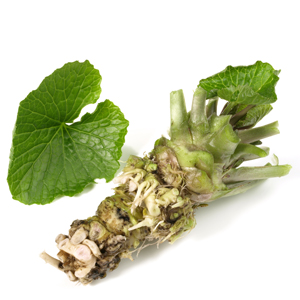
Wasabi Growing Guide
Most of the “wasabi” provided to customers in restaurants is primarily Horseradish root with green-colored food dye. The wasabi powder or packaged paste found in grocery stores have varying amounts of Wasabi mixed with Horseradish, so a lot of people have never really tasted real Wasabi root. Wasabi has a unique flavor and distinctive heat that is much richer than the horseradish-based paste. The usual “wasabi” pastes are essentially starch and heat and not really contributing flavor to the dish. Fresh, real wasabi has a deep vegetal flavor similar to asparagus or artichoke hearts; which is why it pairs so well with so many foods including steak, oysters, noodles, potatoes and of course, fish and sushi.
Cultivation: In its natural habitat you will find Wasabi growing on the shaded wet banks of cold mountain streams. When grown in a home garden Wasabi does best in full shade with steady temperatures between 50-60°F, although the Daruma variety is slightly more tolerant of heat and light. Temperatures below 40°F may slow growth and temperatures below 27°F can kill the entire plant. Temperatures above 80°F can begin to cause heat damage as well as increase the risk of pests and disease. So take this into consideration when selecting a planting site for your Wasabi. The most important tips to follow are providing year-round shade and plenty of summer watering.
Choose a well-drained location with sufficient organic matter. If you’re planting in a pot the container size should be 10 inches or larger (a 2.5-gallon minimum). Work in 10-12 inches of compost to a soil depth of 8-10 inches. Wasabi requires a neutral or slightly acidic soil pH of 6-7. Plant your start only deep enough to keep it upright. Being sure that all of the roots are covered, backfill the hole and gently press into place. Do not cover the rhizome, it needs to be exposed above the surface. Wasabi plants can reach 24 inches in height, so space plants at least 12 inches apart. Water well, but do not let the plant sit in drainage water. After initial planting irrigate regularly with cool water. Mist as necessary to keep plants cool and to avoid wilted leaves. Mulch may increase moisture retention, which will be especially beneficial during warmer months.
Leaves that have been wilted for a week or more should be removed to deter pests and lower the risk of disease. Keep the planting bed or containers weed free and fertilize regularly with a balanced, all-purpose fertilizer. Fertilizers or foliar sprays rich in sulfur may improve the flavor of the rhizome.
Pests and Diseases: Wasabi is a member of the Brassica family. Pests and diseases of this family include aphids, cabbage, and alfalfa looper larva, crane fly larva, and slugs. The best defense against pests and disease is to maintain the cool temperatures and stable irrigation wasabi prefers. Pruning wilted or diseased foliage, hand removal of slugs or use of slug bait, and removal of aphids and other pests are beneficial to the plant’s health. Use caution when using any insecticidal soap or any other insecticides. If any fungal disease is detected it is recommended to remove the plant away from all others to try treating it, or dispose of the plant entirely. Copper spray can be useful in the presence of any fungal complications.
Harvesting: If conditions are optimal, within 24-36 months from the initial planting, you may harvest a four-inch or larger rhizome. In the meantime, you may harvest the petioles (leaf stems), leaves and flowers that bloom in the early spring. All parts of the plant are edible. However, overharvest of leaves can lead to slower rhizome growth.
The whole wasabi plant is edible. Enjoy harvesting and eating the leaves and leaf stems raw or cooked while you wait for your rhizome to grow! When your rhizome is ready to harvest it is recommended to hand dig the plant out of the ground or pot. You can then remove the plantlets that have formed around the crown to be potted or planted and expand your wasabi crop. Trim away the roots and stems and enjoy your fresh wasabi.
Read more details about growing Wasabi in this WSU publication Growing Wasabi in the PNW
